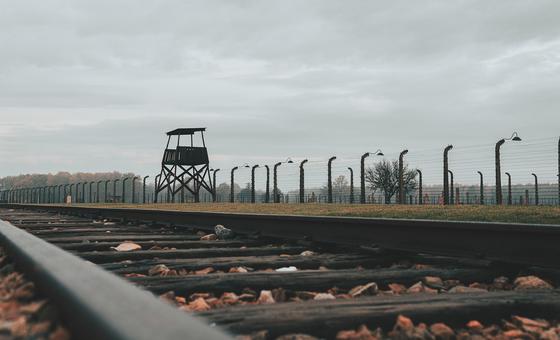In 1933, Hitler began putting the party’s core racist and nationalist ideology into practice, identifying who could claim Germany as home and who in their view, really belonged in the country.
This process went way beyond enacting legislation to define and exclude Jews from society: the Nazis launched misinformation and hate speech campaigns vilifying and dehumanizing Jews, and sanctioned acts of terror that destroyed people’s places of worship, livelihood, and homes.
As Germany gained territory in Europe under the guise of uniting German-speaking peoples, they ensured that similar systematic campaigns took place in the countries under their control.

Jews from Subcarpathian Rus are subjected to a selection process on a ramp at Auschwitz-Birkenau, Poland.
Nazis emboldened by ‘deafening silence’
In his message for the International Day, UN Secretary-General António Guterres notes that the Holocaust was the culmination of thousands of years of antisemitic hate, aided by the decision of so many to do nothing to stop the Nazis. “It was the deafening silence – both at home and abroad – that emboldened them”.
This, he continues, was despite Nazi Germany’s hate speech and disinformation campaigns, contempt for human rights and the rule of law, the glorification of violence and tales of racial supremacy, and disdain for democracy and diversity.
“In the face of growing economic discontent and political instability, escalating white supremacist terrorism, and surging hate and religious bigotry – we must be more outspoken than ever,” added the UN chief, drawing a parallel between the Holocaust and the present day.

Dolls made by stateless Jewish children living in UN displaced persons camp in Florence after the Second World War, on display at UN Headquarters
After the end of the world
The UN Outreach Programme on the Holocaust scheduled a series of events in January and February at UN Headquarters in New York, illustrating the “home and belonging” theme, including a ceremony to mark International Holocaust Remembrance Day, on 27 January.
One of the exhibitions currently on display at the UN, and continuing until 23 February, centres on the experiences of the Jewish refugees who found themselves scattered across Europe, in dire need of help.
After the End of the World: Displaced Persons and Displaced Persons Camps, displays documents and photographs from the archives of the United Nations and the YIVO Institute for Jewish Research, and explains the role of the UN Relief and Rehabilitation Administration (UNRRA), which was set up to resettle those displaced by the war and the Holocaust.
As well as information, and photographs of refugees, the exhibition contains several artifacts, including dolls made by stateless Jewish children who were living in a displacement camp in Florence, Italy, after the war.
Misinformation, stereotypes, and antisemitism

Copy of “Der Giftpilz” (The Poisonous Mushroom), an antisemitic children’s book, on display at UN Headquarters.
Displacement due to conflict and persecution remains a feature today, and misinformation and hate speech, which spread rapidly around the world thanks to the internet, continue to put lives at risk.
Located next to the exhibition on displacement, is another installation illustrating the stereotyping, misinformation, and conspiracy theories used by the Nazis, to vilify Jews, Roma, migrants, LGBTQIA+, or other groups.
The aim of “#FakeImages: Unmask the Dangers of Stereotypes” is to challenge the viewer to unmask the lies that continue to divide and polarize communities, and both exhibitions encourage visitors to draw comparisons with present-day antisemitism. “#FakeImages” is on show until 20 February.
The Book of Names
Until 17 February, visitors to the UN can also see the Yad Vashem Book of Names of Holocaust Victims, which details alphabetically the name of each of the approximately 4.8 million Holocaust victims that Yad Vashem, the World Holocaust Remembrance Center, has so far documented and confirmed.
Whenever possible, the book shows the date of birth, hometown, and place of death of each victim.
The names are taken from Pages of Testimony – forms created by Yad Vashem to record the brief life stories of Jews killed in the Holocaust – as well as from various lists compiled during and following the Holocaust, and subsequently reviewed by Yad Vashem experts.
Visiting the UN:
The exhibitions in the UN lobby are free and open to the public. Guests are welcome to visit the exhibitions during regular hours (Monday-Friday, 9 am – 5 pm). For more information check the United Nations Visitor Centre entry guidelines.

